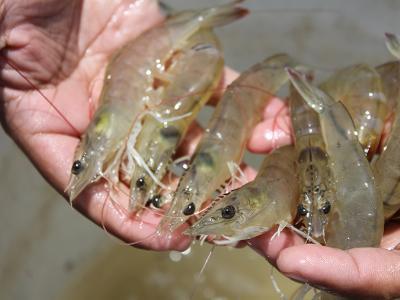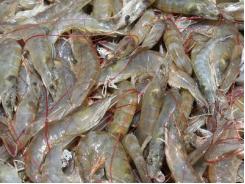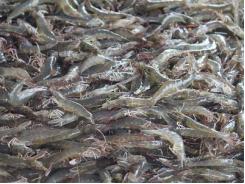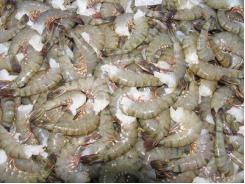Testing shrimp growth in different biofloc systems

Comparing chemoautotrophic- and heterotrophic-based systems receiving different carbohydrate sources
Pacific white shrimp reared in biofloc systems can consume biofloc particles, potentially reducing feed costs while recycling nutrients.
Shrimp and other animals can be grown in biofloc aquaculture systems at high densities with little water exchange. Low water exchange reduces the need for salt water, increases biosecurity and conserves heat. Biofloc technology does not rely on external biological filtration, but rather on a dense microbial community that develops in the water column. A portion of this community is on and within biofloc, which are small organic particles consisting of excretions, feed particles, detritus, and microbes, all held together by exopolymeric secretions. Evidence suggests that shrimp can consume these particles, thereby recycling nutrients and potentially reducing feed costs.
There are three pathways for the remediation of ammonia in biofloc systems: algal assimilation, chemoautotrophic bacterial oxidation, and heterotrophic bacterial assimilation. These processes, as they apply to aquaculture, are reviewed in detail by Ebeling et al. (2006). Algae are limited in the amount of nutrients they can assimilate, therefore intensive biofloc systems are typically dominated by bacteria (Brune et al., 2003).
Heterotrophic bacteria utilize organic carbon as an energy source and assimilate nitrogen to build cellular proteins. By adding carbohydrates to the water heterotrophic assimilation can rapidly remove ammonia. Heterotrophic bacterial assimilation can consume dissolved oxygen (DO) at a higher rate than nitrification, and the bacterial population must expand to continually assimilate ammonia, leading to an accumulation of solids in the water column. However, it has been suggested that using this method may contribute to better shrimp growth and feed conversion efficiency.
In heterotrophically dominated biofloc systems, the carbon source added may affect system function or animal production. Sucrose is readily available in many markets due to its use in food products, it dissolves quickly in water, and it has been shown to successfully facilitate bacterial assimilation of nitrogen. Molasses is a less expensive byproduct of the sucrose manufacturing process that can be an appropriate carbon source to stimulate heterotrophic assimilation. Glycerol is a byproduct of the biodiesel manufacturing process, and has been shown to help generate potentially nutritious biofloc that may help protect animals from Vibrio harveyi bacterial infections.
This article summarizes the shrimp growth portion of the original publication in Aquacultural Engineering 63 (2014) 54–61. This study evaluated the differences in system function and shrimp production between a chemoautotrophic, nitrification-dominated system and three heterotrophic-dominated systems that were established and maintained using sucrose, molasses or glycerol.
Study setup
This study was conducted at the Aquaculture Research Center of Kentucky State University (Frankfort, KY USA), using 16 fiberglass tanks (500 L) in a greenhouse covered with two layers of clear plastic sheeting. Each tank was aerated with ceramic diffusers and a regenerative blower, and because this study was carried out during the winter, each tank had two 300 W, electric, submersible heaters. Adjacent to each shrimp culture tank was a 15-L cylindrical container used as a settling chamber. An airlift mechanism carried water from the shrimp culture tank into the settling chamber where water velocity slowed as it traveled down a 5 cm diameter pipe. Clarified water near the top of the chamber flowed through another pipe back into the respective shrimp culture tank.

View of the experimental tanks used in this study.
Twelve-day-old post larval shrimp (Litopenaeus vannamei) were obtained from a commercial supplier and grown in an 80-m3 raceway at 100 shrimp/m3 for 75 days. The water and shrimp used for the current study were obtained from this raceway. This water was used because it contained biofloc (total suspended solids = 326 mg/L), and it contained nitrate (6.5 mg NO3-N/L), indicating that the process of nitrification had occurred. The weight (± standard error) of shrimp at the time of stocking this study was 6.8 ± 0.2 g. Each shrimp culture tank received 500 L of water from the source raceway and 150 shrimp for a stocking density of 300 shrimp/m3 or 150 shrimp/m2. Shrimp were grown for 56 days and fed a commercial, hyper-intensive diet. Nets were used to occasionally check for uneaten feed in the tanks. The amount of uneaten feed, along with weekly weight gain and temperature, was used to adjust feeding rates.
In the experimental design used, four treatments were tested. The chemoautotrophic treatment (CA) was intended to facilitate the function of chemoautotrophic, nitrifying bacteria by adding only feed to the tanks. In the other three treatments the regular addition of carbohydrates was intended to encourage the assimilation of ammonia by heterotrophic bacteria. Sucrose was added to one heterotrophic treatment (HS). Molasses was added to another heterotrophic treatment (HM). Glycerol was added to the third heterotrophic treatment (HG). Each of the 4 treatments was randomly assigned to 4 replicate tanks. Each carbohydrate type was added to the heterotrophic tanks twice per day, between feedings. The C:N ratio of inputs (feed and carbohydrate) was 22:1. Because the only source of organic carbon in CA tanks was the feed, the C:N ratio of inputs into those tanks was 8.4:1.
Settling chambers were operated based on turbidity measurements which were shown to be an effective management method by Ray et al. (2010a), and the flow rate of each was approximately 5 L/min. Every morning turbidity was measured in each tank, and when turbidity was greater than 150 NTU in a tank, that tank’s settling chamber was operated until 1700 h, if the turbidity was greater than 225 NTU in a tank the settling chamber was operated until the following morning. Each tank was operated at a salinity of 16 g/L and a volume of 500 L. To replace evaporation municipal water was added as needed. To replace the volume of water removed with the settling chambers, clean artificial seawater was added.

One of the settling chambers used in the study to remove solids.
For more detailed procedures on the experimental setup – including chemical analysis, oxygen demand calculations, and statistical analyses – refer to the original publication.
Experiment results
Regarding C:N management, sucrose contained 41 percent C, molasses contained 24 percent C, and glycerol contained 35 percent C (wet weights). The feed contained 44.4 percent C, 5.3 percent N, and 8.6 percent moisture. Each shrimp culture tank received 1854 g of feed throughout the study and the heterotrophic tanks received a corresponding amount of carbohydrate to equal the 22:1 C:N ratio of inputs. The high ratio was intended to ensure the domination of heterotrophic bacteria in those systems. The ratios were calculated based on the weight of the components added to the culture systems and the percent carbon and nitrogen content of those components (feed and carbon source).
Low temperatures were recorded during this study, especially low nighttime temperatures as reflected in the morning measurements. The DO concentration, pH, and salinity all remained within an acceptable range for the growth of L. vannamei.
Regarding shrimp production, the weekly mean ± SEM shrimp growth rate was 0.7 ± 0.1 g/wk. in the CA treatment, 0.7 ± 0.0 g wk./in the HS treatment,0.3 ± 0.2 g/wk. in the HM treatment, and 0.6 g/wk. in the HG treatment. There were no significant differences (P > 0.05) in growth rate between any of the treatments. Mean ± SEM shrimp survival was 45.2 ± 3.6 percent in the CA treatment, 53.2 ± 8.9 percent in the HS treatment, 21.6 ± 7.1 percent in the HM treatment, and 49.2 ± 7.3 percent in the HG treatment. There were no significant differences (P > 0.05) in survival between treatments with the exception of significantly lower (P < 0.05) survival in the HM compared to the HS treatment.
Shrimp growth rates and survival in the CA, HS, and HG treatments may have been improved had temperature been more ideal during the study. Both growth rate and survival were unacceptably low in the HM treatment. High ammonia concentrations in the HM treatment may have contributed to the poor shrimp production. Also, the rapid drops in DO concentration after molasses addition may have led to some undetected lethal DO concentrations. The rapid DO concentration drop also may have stressed the shrimp, potentially contributing to poor production. Furthermore, the low concentration of carbon in molasses implies that there is a higher concentration of unusable components in this carbohydrate source. Components other than carbon may have fouled the water, lending some contamination.

Water from the experimental tanks took on different colors based on treatment.
Shrimp production was similar among the HS, HG, and CA treatments, suggesting the potential equivalency of these management strategies. The addition of carbohydrates, increased oxygen demand, and larger volume of solids generated in the heterotrophic treatments represent costs of operation that were not factors in the chemoautotrophic treatment.
Perspectives
The results of this study indicate that managing biofloc systems to function in a chemo-autotrophic fashion may be financially superior to heterotrophic function. However, ammonia and nitrite concentrations should be monitored carefully, especially during the first few weeks of operating a chemoautotrophic-dominated biofloc system. Options for mitigating the effects of those toxic nitrogen compounds should be explored, such as temporarily adding a carbohydrate source to elevate the C: N ratio.
When water is reused for multiple crops, which is essential for inland shrimp culture, the concentration of nitrate will increase. This accumulation of nitrate must be remediated, possibly through denitrification. Performing denitrification in biofloc systems will present added cost and this cost must be weighed against those of heterotrophic-dominated systems. Ultimately, nitrogen, oxygen, and solids dynamics, as well as long term water use options must be considered with respect to the methods of biofloc system management.
References available from first author.
Andrew J. Ray, Ph.D.
Aquaculture Research Center, Kentucky State University, 103 Athletic Rd., Frankfort, KY 40601 USA
Jeffrey M. Lotz, Ph.D.
Department of Coastal Sciences, Gulf Coast Research Laboratory, The University of Southern Mississippi, 703 East Beach Drive, Ocean Springs, MS 39564 USA
Related news
Tools

Phối trộn thức ăn chăn nuôi

Pha dung dịch thủy canh

Định mức cho tôm ăn

Phối trộn phân bón NPK

Xác định tỷ lệ tôm sống

Chuyển đổi đơn vị phân bón

Xác định công suất sục khí

Chuyển đổi đơn vị tôm

Tính diện tích nhà kính

Tính thể tích ao




 NIRS technology ensures shrimp feed quality at farm…
NIRS technology ensures shrimp feed quality at farm…  Critical decisions for shrimp harvesting and packing, Part…
Critical decisions for shrimp harvesting and packing, Part…